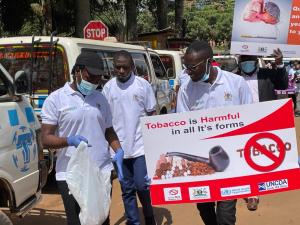Ending Tobacco Farming Leads To A Healthy Environment And A Healthier Population
Op-ed - The tobacco epidemic is one of the biggest public health threats the world has ever faced. Tobacco kills more than 8 million people every year, and around 1.2 million of these deaths are due to exposure to second-hand smoke. This is far greater compare to deaths due to COVID-19 and it has been going on for decades.
The whole tobacco production cycle is highly destructive. From farming, and manufacturing, to consumption, tobacco causes widespread environmental degradation and harm to health. Growing tobacco plants requires large quantities of chemicals and many of these chemicals are so harmful to both the environment and farmers’ health leading to illnesses.
Every year, 600 million trees are cut down to make six-trillion cigarettes. This deforestation contributes to increased carbon dioxide emissions in the environment leading to harmful climate change.
In addition, cigarette butts are the most abundant form of plastic waste in the world. They are responsible for 767,000 kg of toxic waste each year, and 4.5 trillion cigarettes litter our cities, parks, beaches, and waterways, polluting land and water.
Tobacco use increases among the youth
WHO estimates that one in every ten African adolescents uses tobacco. The emergence of new products such as electronic nicotine increases consumption drastically.
The theme for this year’s World No Tobacco Day is “Protect the Environment”. It is a reminder for us to take concrete and urgent actions to keep our environment healthy and safe.
It is important to note that every awareness-raising effort this year should be aimed at protecting our environment and our health. The call was already made in 2003 when the World Health Assembly adopted the WHO Framework Convention on Tobacco Control (FCTC) that addresses some of the causes of the tobacco epidemic, including complex factors with cross-border effects.
To date, the FCTCT has been ratified by 44 of the 47 WHO African Member States, of which 24 have instituted bans on smoking in public places, and 35 have banned tobacco advertising, promotion, and sponsorship.
This is commendable, but more efforts are needed to completely tackle the tobacco epidemic.
Lessons from Kenya
There are good lessons from the Republic of Kenyan that is implementing the Tobacco-Free Farms project that Uganda may wish to consider.
Coordinated by WHO and in close collaboration with the Food and Agriculture Organization of the United Nations, the Kenyan government supports farmers to switch from tobacco to alternative food crops, that will help to feed communities, rather than harm their health.
So far, 330 Kenyan farmers have switched to growing beans, with the first harvest yielding more than 200 metric tons. The second season, which has just begun, is now reaching more than another 1000 farmers.
If Uganda and other African countries adopt this type of strategy today, within a few years, tobacco could cease to be a major public health problem on the continent.
On this year’s World No Tobacco Day, the WHO Regional Director for Africa, Dr. Matshidiso Moeti, calls on African governments to impose more environmental tax levies on tobacco across the value and supply chains, including production, processing, distribution, sales, consumption, and waste management.
This is a call we all need to heed to have a healthy environment, a healthier population and raise a tobacco-free generation.
The Author of this op-ed is the WHO Representative to Uganda, Dr. Yonas Tegegn Woldemariam.
